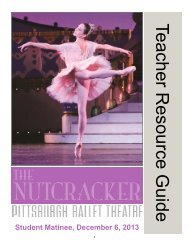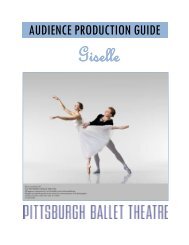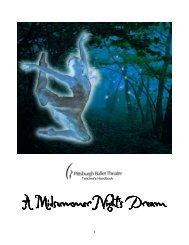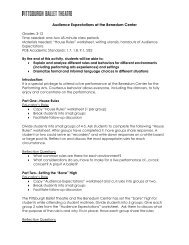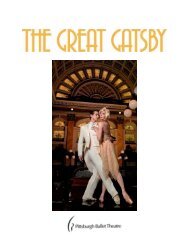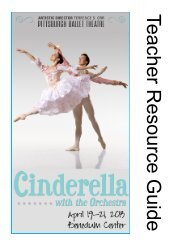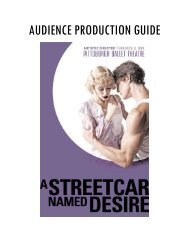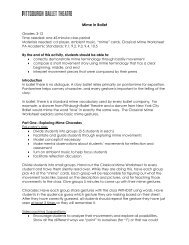You also want an ePaper? Increase the reach of your titles
YUMPU automatically turns print PDFs into web optimized ePapers that Google loves.
AUDIENCE PRODUCTION GUIDE
Audience Production Guide for<br />
<strong>Pittsburgh</strong> <strong>Ballet</strong> <strong>Theatre</strong>’s<br />
Coppélia<br />
April 13-15, 2012<br />
The Benedum Center for the Performing Arts<br />
Production Sponsors<br />
Family Series Sponsor Student Matinee Sponsor In-Step Sponsor<br />
<strong>Pittsburgh</strong> <strong>Ballet</strong> <strong>Theatre</strong>’s Arts Education programs are also supported by the following:<br />
Allegheny Regional Asset District<br />
Allegheny Technologies, Inc.<br />
Buncher Family Foundation<br />
Anne L. and George H. Clapp Charitable and<br />
Educational Trust<br />
Claude Worthington Benedum Foundation<br />
Cleveland Brothers Equipment Co., Inc.<br />
Direct Energy Business<br />
Dominion Foundation<br />
Eat ‘n Park Restaurants, Inc.<br />
ESB Bank<br />
First Commonwealth Bank<br />
Henry C. Frick Educational Fund of The Buhl<br />
Foundation<br />
The Huntington National Bank<br />
GENCO Supply Chain Solutions<br />
The Grable Foundation<br />
Hefren-Tillotson, Inc.<br />
The Heinz Endowments<br />
Net Health Systems<br />
Peoples Natural Gas<br />
Pennsylvania Council on the Arts<br />
Pennsylvania Department of Community and<br />
Economic Development<br />
PNC Bank<br />
PPG Industries, Inc.<br />
Richard King Mellon Foundation<br />
James M. and Lucy K. Schoonmaker<br />
Foundation<br />
Edith L. Trees Charitable Trust<br />
UPMC Health Plan<br />
Hilda M. Willis Foundation<br />
Cover photo by Duane Rieder<br />
Production Guide created by PBT’s Department of Arts<br />
Education and Community Engagement, 2012<br />
2
Contents<br />
4 Coppélia<br />
4 The Benedum Center for the Performing Arts<br />
5 The Foundation: Hoffmann’s Short Story<br />
The Sandman<br />
6 Writer E.T.A. Hoffmann<br />
7 Coppélia: A Story <strong>Ballet</strong><br />
7 What is a Story <strong>Ballet</strong>?<br />
Synopsis of Coppélia<br />
9 Choreographer Arthur Saint-Léon<br />
10 Music: Léo Delibes<br />
11 Costumes in Coppélia<br />
13 Coppélia and Pantomime<br />
14 How Coppélia almost never happened<br />
15 Coppélia in our Culture<br />
Coppélia production history<br />
16 The story in other genres<br />
17 For the Kids<br />
Make your own Russian Doll!<br />
18 Coppélia Word Search<br />
19 Review • Reflect • Respond<br />
How the Critics Responded<br />
Discussion Questions<br />
3
Coppélia<br />
A perennial favorite of dancers and audience members alike, Coppélia delights with<br />
playful comedic antics and a “magical” storyline as a doll comes to life. Despite now<br />
being considered one of the classics, Coppélia was novel in its time as it broke away<br />
from Romantic stylings and incorporated comedy and folk dancing into its<br />
choreography. The production has become a staple of many companies’ repertoire, and<br />
this version of Coppélia has been performed by PBT by 1998, 2002, and 2006.<br />
PBT Artistic Director Terrence S. Orr and PBT dancer<br />
teaching youth movements from Coppélia at a Family Pointe<br />
lecture in 2002.<br />
The Benedum Center for the Performing Arts<br />
The Benedum Center for the Performing Arts<br />
is the crown jewel of the <strong>Pittsburgh</strong> Cultural<br />
Trust and the Cultural District in downtown<br />
<strong>Pittsburgh</strong>. It was renovated in 1987 and is<br />
on the National Register of Historic<br />
Landmarks. The 2800 seat theatre used to be<br />
the Stanley Theater, still visibile on the<br />
lighted marquees outside. It has the third<br />
largest stage in the United States measuring<br />
144 feet wide by 78 feet deep. The <strong>Pittsburgh</strong><br />
<strong>Ballet</strong> <strong>Theatre</strong>, <strong>Pittsburgh</strong> Opera, and<br />
<strong>Pittsburgh</strong> Civic Light Opera all use the<br />
Benedum for their performances.<br />
Learn more about the Benedum Center:<br />
http://trustarts.org/visit/facilities/benedum/benedum-center-history<br />
Investigate the Stanley <strong>Theatre</strong>’s role in music history here in <strong>Pittsburgh</strong>:<br />
http://www.wyep.org/music/ppp/page12.php<br />
4
The Foundation: Hoffmann’s Short Story<br />
The Sandman<br />
The story of the ballet Coppélia is derived from a<br />
short story by the German Romantic author E.T.A.<br />
Hoffmann (for Hoffmann’s biography, see below),<br />
called The Sandman (Der Sandmann). The<br />
Sandman was published as part of Hoffmann’s first<br />
short story collection, Phantasiestücke in Callots<br />
Manier (Fantasy Pieces in the Callots Manner), in<br />
1815. Many internet sources cite that the ballet also<br />
comes from a short story called The Doll (Die<br />
Puppe), but with help from the reference librarians at<br />
the Carnegie Library of <strong>Pittsburgh</strong>, we have<br />
determined that no short story of this name by<br />
Hoffmann exists in published form.<br />
Like most of his writings, The Sandman represents<br />
many hallmark characteristics of literary and artistic<br />
Romanticism, including fantastical elements, such<br />
as automatons and supernatural beings; strong<br />
elicitation of emotions, particularly horror;<br />
enthusiasm for the grotesque; and a revelation of the<br />
inner and hidden truth of the world we live in. Read<br />
the excerpt below about the story’s main character,<br />
Nathanial, and his love for Olympia:<br />
Cover of book from 1986 version<br />
(Publisher: Insel).<br />
Source:http://openlibrary.org/works/<br />
OL969770W/Der_Sandmann<br />
“Nathaniel had totally forgotten the very existence of Clara, whom he had once loved;<br />
his mother, Lothaire - all had vanished from his memory; he lived only for Olympia, with<br />
whom he sat for hours every day, uttering strange fantastical stuff about his love, about<br />
the sympathy that glowed to life, about the affinity of souls, to all of which Olympia<br />
listened with great devotion. From the very bottom of his desk he drew out all that he<br />
had ever written. Poems, fantasies, visions, romances, tales - this stock was daily<br />
increased by all sorts of extravagant sonnets, stanzas and canzoni, and he read them<br />
all tirelessly to Olympia for hours on end. Never had he known such an admirable<br />
listener. She neither embroidered nor knitted, she never looked out of the window, she<br />
fed no favorite bird, she played neither with lapdog nor pet cat, she did not twist a slip of<br />
paper or anything else in her hand, she was not obliged to suppress a yawn by a gentle<br />
forced cough. In short, she sat for hours, looking straight into her lover's eyes, without<br />
stirring, and her glance became more and more lively and animated. Only when<br />
Nathaniel rose at last, and kissed her hand and her lips did she say, 'Ah, ah!' to which<br />
she added: 'Good night, dearest.’”<br />
The ballet Coppélia, as the synopsis on page 7 indicates, captures the allencompassing<br />
love and passion told in the story but loses the darker elements. Instead<br />
of telling the audience members about a higher supernatural power, the ballet is<br />
5
grounded in the earthly reality of robust peasants and a mechanical doll, full of comic<br />
lightness, and a happy ending for all.<br />
Read the full story of The Sandman:<br />
http://www.has.vcu.edu/for/hoffmann/sand_e_pics.html<br />
Self-portrait.<br />
Source:http://www.dartmouth.edu/~<br />
german/German7/German7.html<br />
Writer E.T.A. Hoffmann<br />
Ernst Theodore Amadeus Hoffmann was a German<br />
writer, artist, and composer from the 19th century<br />
German Romantic period. Born in 1776, Hoffmann<br />
was raised by his mother and extended family<br />
members. Having come from a long line of jurists,<br />
Hoffmann was learned in legal matters and pursued<br />
the study of law. Prior to Napoleon’s conquering of the<br />
Polish provinces, he worked as a Prussian law officer.<br />
Shortly after the defeat of the Polish provinces,<br />
Hoffmann turned his interests to the arts.<br />
Despite his achievements in academics, Hoffmann<br />
was very much the artist. His interest in music piqued<br />
early and he learned to play the piano from a young<br />
age; this skill was later to assist in his career as a<br />
composer. He began by writing critiques and reviews<br />
of music which led to regular work as a critic. In<br />
1808, he was offered a position in the city of<br />
Bamberg as theatre director and later worked as a conductor in Dresden.<br />
During this time he also contributed to the great literary works of the German Romantic<br />
period. Hoffmann is the author of two novels and over 50 short stories. He also<br />
composed the ballet Arlequin and the opera Undine. His literary works are often wildly<br />
creative, but reflect the deeper and often darker side of human nature. Today, his works<br />
have been adapted into many forms of theatre and dance. Besides Coppélia, his most<br />
recognizable contribution is his story of “The Nutcracker and the Mouseking” which has<br />
been adapted and performed annually as The Nutcracker by ballet companies across<br />
the globe. Although Hoffman died nearly 200 years ago, his works still play a pivotal role<br />
in modern literature and theatre.<br />
Explore other literary works by Hoffmann:<br />
http://www.gutenberg.org/browse/authors/h#a2008<br />
Connect Hoffmann’s style with Freud’s idea of “The Uncanny” in an essay by Kyla<br />
Ward: http://www.tabula-rasa.info/DarkAges/Hoffmann.html<br />
Did you know?<br />
Coppélius and Coppélia derive from the Italian word for “Coppo” or “eye socket.” In the<br />
original Hoffmann story, the evil figure of Coppelius, or The Sandman, would come<br />
and steal the eyes of children who refused to go to sleep!<br />
6
Coppélia: A Story <strong>Ballet</strong><br />
Choreography Arthur Saint-Léon<br />
Staged at PBT by Terrence S. Orr<br />
Music Léo Delibes<br />
Libretto Charles Nuitter and Arthur Saint-Léon (after E.T.A. Hoffmann)<br />
World Premiere May 25, 1870, <strong>Theatre</strong> Impérial de l'Opéra Paris<br />
What is a Story <strong>Ballet</strong>?<br />
A story ballet is exactly what the name implies—it is a ballet that tells a story! Story<br />
ballets, unlike concept ballets, have a clearly discernible plotline that they follow with<br />
identifiable characters. Sometimes these stories would be common folk or fairy tales,<br />
such as Sleeping Beauty or Cinderella. Other story ballets would be based on preexisting<br />
stories by literary authors, such as E.T.A. Hoffmann’s stories as the foundation<br />
for both Coppélia and The Nutcracker. Other story ballets have unknown origins, such<br />
as Swan Lake.<br />
Act I<br />
Synopsis of the <strong>Ballet</strong><br />
In the village square stands the house of Dr. Coppélius the toymaker. The young<br />
Swanilda tries to attract the attention of Coppélia, a strange girl whom the village<br />
inhabitants suppose to be the old magician-craftsman's daughter. Sitting, as always,<br />
still and serious in the window, Coppélia is a source of fascination for Franz, even<br />
though he is betrothed to Swanilda.<br />
When the square is empty, Dr. Coppélius comes out of his house and goes off, absentmindedly<br />
dropping his key. Swanilda and her friends find it and, overcome with curiosity,<br />
enter the house. Coppélius returns, anxiously looking for his key and sees his door<br />
open, dashes into the house. Franz, thinking the doctor is away, also enters the house<br />
by means of a window.<br />
Act II<br />
Inside, the girls enter the old man's workshop on tiptoe. Swanilda sees Coppélia seated<br />
in the corner and discovers to her joy that the figure is only a mechanical doll.<br />
Meanwhile the others amuse themselves by turning on all the automatons with which<br />
the workshop is filled. Coppélius bursts seriously into the room and all the intruders run<br />
away. Only Swanilda has not been able to reach the door in time; instead, she hides in<br />
Coppélia's corner, taking the place of the doll.<br />
Franz arrives and, surprised by the indignant magician, confesses that he loves<br />
Coppélius' "daughter"and would like to marry her. Feigning friendliness, Coppélius<br />
offers his guest a drink spiked with a sleeping potion. When Franz falls senseless to the<br />
chair, the doctor calls on his magic arts to transfer the young man's life to the doll<br />
Coppélia, which he loves as if it were really his daughter. Swanilda, still disguised as<br />
Coppélia, falls in with the plan and pretends to progress gradually from mechanical<br />
movements to a radiant human vitality. To the amazed delight of the old man, she<br />
7
performs two brilliant dances, until tired of the joke. She capriciously turns the<br />
workshop upside-down and wakes Franz, then shows the doctor the real Coppélia in<br />
the corner. The young lovers go off happily together, yet their moment is bittersweet as<br />
Coppélius sadly embraces his cold automaton.<br />
Act III<br />
Backdrop for PBT’s production of Coppélia.<br />
In the village square the marriage of Swanilda and Franz is celebrated with festive<br />
dances, interrupted only by the wedding ceremony and one last, short appearance of<br />
the misanthropic Coppélius.<br />
Browse through an online storyboard from the Birmingham Royal <strong>Ballet</strong> (synopsis<br />
may differ slightly from PBT’s version): http://www.brb.org.uk/coppelia-storyguide.html<br />
Download the Boston <strong>Ballet</strong>’s storybook for George Balanchine’s version of<br />
Coppélia: http://www.bostonballet.org/making-of-coppelia.html<br />
View different artists’ interpretations of Coppélia in conjunction with the Royal<br />
Birmingham <strong>Ballet</strong>: http://www.pointeblank.co.uk/category/2011-coppelia/<br />
Read famed ballerina Margot Fonteyn’s illustrated children’s book, Coppélia:<br />
http://www.amazon.com/<strong>Coppelia</strong>-Margot-Fonteyn/dp/0152004289<br />
Did you know?<br />
This ballet is a challenging feat for the ballerina playing Swanilda. Why? Because she<br />
rarely leaves the stage during all three acts!<br />
8
Porcelain figure by artist Allison<br />
Delarue of Fanny Cerrito (1821-<br />
1909) and Arthur Saint-Léon<br />
(1821-1870), mount for a clock.<br />
25.5 x 17 x 9.5 cm.<br />
Source:http://blogs.princeton.edu/<br />
graphicarts/2011/07/allison_delar<br />
ue.html<br />
Paris Opera from 1851 to 1852. He did short stints in<br />
London, Portugal, and other European cities until his next<br />
big appointment as <strong>Ballet</strong> Master for the Imperial Theaters<br />
in St. Petersburg, Russia, in 1859. During his eight years<br />
with the Imperial Theaters, Saint-Léon had time to travel<br />
back and forth between Russia and other European<br />
countries. It was during this time that Coppélia was<br />
created. He was commissioned by the Paris Opera in 1868<br />
to choreograph Coppélia and it debuted in Paris on May 25,<br />
1870. Just three months after the debut of Coppélia, on<br />
September 2, 1870, Saint-Léon died of a heart attack in<br />
Paris. To date, only his ballet Coppélia is performed, but it<br />
is a main component of many ballet companies around the<br />
world.<br />
Arthur Saint-Léon was one of the most sought after<br />
dancers, violinists, and choreographers of his time. He<br />
developed a system of dance notation, La<br />
Sténochoréographie, and the only surviving manuscript,<br />
pas de six from La Vivandiere, was translated into<br />
Labanotation in 1996 by Anne Hutchinson Guest. He, in<br />
collaboration with librettist Charles Nuitter and composer<br />
Léo Delibes, brought comedy and national dances into the<br />
Choreographer Arthur Saint-Léon<br />
Arthur Michel Saint-Léon was born in Paris on<br />
September 17. Historians dispute his birth year as<br />
either 1815 or 1821. His father was the <strong>Ballet</strong> Master of<br />
the Wuertemberg Ducal Theater, Stuttgart, in addition<br />
to being a dancer and fight choreographer for the Paris<br />
Opera. His father encouraged Saint-Léon to delve into<br />
the worlds of dance and music. By the young age of<br />
13, Saint-Léon made his debut as a violinist after<br />
studying with both Mayseder and Paganini. Just one<br />
year later he made his debut as a dancer in<br />
Schneider's ballet Die Reisande <strong>Ballet</strong>-Gesellschaft.<br />
In 1833, Saint-Léon began to travel throughout Europe<br />
for various appearances, and over the next two and a<br />
half decades, Saint-Léon choreographed numerous<br />
ballets in a variety of European cities beginning with La<br />
Vivandiere ed il Postiglione. After his marriage to<br />
renowned ballerina, Fanny Cerrito in 1845, he went on<br />
to create numerous roles for Cerrito, including the role<br />
of "Phoebus" in Jules Perrot's ballet La Esmerelda and<br />
La Fille de Marbre for her debut at the Paris Opera.<br />
After the success of La Fille, Saint-Léon produced 16<br />
ballets and divertissements for the Paris Opera and<br />
went on to hold the title of Principal <strong>Ballet</strong> Master of the<br />
9<br />
Lithographic music cover of<br />
The Real Redowa Polka by<br />
Cesare Pugni, as danced by<br />
Mlle. Cereto and Mons. St.<br />
Léon. New York: Firth, Hall &<br />
Pond, 1850.<br />
Source:http://www.abaa.org/bo<br />
oks/283485667.html
world of ballet, bridging the Romantic and Classical periods.<br />
Read Brittanica Encyclopaedia’s online biography of Saint-Leon:<br />
http://www.britannica.com/EBchecked/topic/517616/Arthur-Saint-Leon<br />
Clement Philibert Léo Delibes (1836 – 1891)<br />
composed a variety of scores for operas,<br />
operettas, and ballets. One of the most<br />
enduring is Coppélia (1870), thought to have<br />
moved ballet music toward a more expressive<br />
character and descriptive tone.<br />
Coppélia was the first complete ballet score<br />
written solely by Delibes, and this ballet became<br />
popular, and has remained so, mainly because<br />
of his music. When creating the score he<br />
combined classical elements with folk and<br />
dance music styles. Delibes also used the<br />
leitmotif as a way of identifying certain<br />
characters and setting moods. (A leitmotif is "a<br />
short musical phrase which accompanies the<br />
reappearance of a certain person or situation<br />
during the performance - a sort of musical<br />
label.") Wagner later used this same technique in his operas.<br />
Music: Léo Delibes<br />
Source:<br />
http://www.music.vt.edu/musicdictionary/a<br />
ppendix/composers/D/LeoDelibes.html<br />
Other well-known works by Delibes include the ballet Sylvia and the opera Lakmé. Delibes'<br />
work is known to have been a great influence on composers such as Tchaikovsky, Saint-<br />
Saëns, and Debussy.<br />
In a letter to Sergei Taneev in December 1877 from Venice, Tchaikovsky mentions his<br />
negative impressions of Wagner's Die Walküre in Vienna, and how “On the other hand, I<br />
also heard in Vienna the ballet Sylvia by Leo Delibes—yes, I mean 'heard' because this<br />
is the first ballet in which the music constitutes not just the principal, but also the sole<br />
interest. What charm, what gracefulness, what melodic, rhythmic, and harmonic<br />
richness! I was ashamed of myself. If I had known this music before, I wouldn't have<br />
written The Lake of Swans.”<br />
(http://www.tchaikovskyresearch.org/en/people/delibes_leo.html_)<br />
Listen to excerpts of Delibes Coppélia from a variety of recordings:<br />
http://www.classicalarchives.com/work/8430.html<br />
Investigate the legacy Delibes had on ballet’s greatest composer, Tchaikovsky:<br />
http://www.tchaikovsky-research.org/en/people/delibes_leo.html<br />
10
Costumes in Coppélia<br />
The costumes for Coppélia are<br />
ethnically-based and greatly<br />
influenced by the peasant costume<br />
traditions of central and Eastern<br />
Europe in the 19 th century. Charles<br />
Nuitter and Arthur Saint-Léon<br />
relocated E.T.A. Hoffmann's story<br />
from Germany to Galicia because it<br />
was thought to be more colorful.<br />
Galicia, in 1869, was a northern<br />
province of what was Austria-<br />
Hungary.<br />
Source:<br />
http://www.ualberta.ca/~german/PAA/Galicians.htm<br />
On today's global map, that area lies in southeastern Poland<br />
and western Russia. The brilliant colors of the peasant<br />
dress during that era consisted of heavily embroidered<br />
fabrics with extensive trimmings of braid and lace. These<br />
colors and fabrics provided designers, both then and now,<br />
with a rich palette to create a real fairy tale canvas that<br />
would delight the eyes of the audience.<br />
Hungarian couple dressed in folk<br />
costume for a wine harvest celebration,<br />
Kalotaszeg region, Transylvania.<br />
Photo by Prof. Ágnes Fülemile<br />
Source:http://www.indiana.edu/~ceus/i<br />
mages.shtml<br />
Our production of Coppélia had its first home at American <strong>Ballet</strong> <strong>Theatre</strong> and was<br />
acquired by the company in 1997 by our newly-appointed Artistic Director, Terrence S.<br />
Orr. The previous version PBT had been using looked tired and worn. With no money in<br />
the budget to mount a new production he decided to acquire, on his own, the beautiful<br />
production from ABT that he had grown to love during his tenure there as both a dancer<br />
and ballet master. The sale, purchase, and rental of productions among ballet<br />
companies are a common practice. Luckily, ABT was mounting a new <strong>Coppelia</strong> at the<br />
same time and this one was available. Acquiring ABT’s set and costumes was Mr. Orr's<br />
first step toward spicing up PBT's Coppélia. He also took the liberty of enhancing the<br />
story characterizations and choreography, another artistic license afforded to those<br />
staging and directing ballets.<br />
At this point <strong>Pittsburgh</strong> <strong>Ballet</strong> <strong>Theatre</strong>'s Costumier, Janet Campbell, entered the picture<br />
to mold these costumes to PBT's standards and its dancers. It was a monumental task,<br />
but a challenge that our costumier and her staff accepted with glee. Janet tells us what<br />
she looks for when first seeing a new production wardrobe.<br />
11
“Originally designed by New York designer William “Billy” Pitkin, this<br />
‘Coppélia’ was premiered by American <strong>Ballet</strong> <strong>Theatre</strong> on December 24,<br />
1968 at the Brooklyn Academy of Music. What first took my eye was the<br />
high quality of construction. A costumier cannot only look at the<br />
appearance of the costumes because the construction tells how long they<br />
will last and how prone to damage they will be as they are worn in<br />
performance. Costumes that are constantly in need of major repairs are<br />
costly and risky, but these costumes were beautifully made, as proven, by<br />
their longevity. They have also been worn, in the course of their life, by<br />
many famous dancers.<br />
In addition to masterful construction, these costumes were built [costumes<br />
are ‘built’ not made] with some of the most beautiful fabrics and trimmings<br />
I have ever seen. Some of the costumes were worn out and did have to<br />
be replaced. Because some of the rich and beautiful trimmings were no<br />
longer available, we removed them from the worn-out costumes and<br />
placed them on the new costumes following the same design – a very<br />
arduous and cautious task requiring much patience.”<br />
Besides their high quality and stunning beauty, we asked Janet what makes Coppélia<br />
unique in the world of ballet costumes.<br />
“One of the most notable things about William Pitkin’s designs is how<br />
unusual it was for him to use a brilliant yellow for the principal role of<br />
Swanilda. Most often you find the principal female dressed in a pastel<br />
pink, so this yellow is a daring departure.<br />
Also, the weight of the villagers’ and friends’ costumes is significant. The<br />
fabrics and trimmings are heavier in keeping with the authenticity of the<br />
ethnic peasant dress; they also complement the weight of the<br />
choreography in the nationality dances. The czardas and mazurka are<br />
strong and heavy dances. The weight of these village dances also<br />
influences the dancers’ footwear. Only Swanilda and her friends are in<br />
pointe shoes. The other girls wear boots for the czardas and character<br />
shoes for the mazurka.<br />
All of the men wear boots, however, Franz’s friends have soft boot tops for<br />
their ballet shoes to allow for their challenging choreography, especially in<br />
Act I.<br />
There are also some other interesting costume switches when Swanilda<br />
and her friends sneak into Dr. Coppélius’ toyshop.”<br />
Keeping the costumes for a ballet company properly fitted and in good repair is a neverending<br />
job. In fact, the bright yellow costume for Swanilda was getting so tattered that it<br />
has to be rebuilt for the 2012 production. Costumier Janet Campbell has one assistant,<br />
two full-time seamstresses, a wardrobe mistress during production week, plus other<br />
part-time and volunteer helpers when needed.<br />
12
Coppélia and Pantomime<br />
Pantomime is the art of storytelling—without words. It relies solely on commonplace,<br />
easily understood gestures to communicate feelings, ideas, and character traits. Often,<br />
these gestures have universal characteristics that can transcend cultural and language<br />
barriers. Dancers learn pantomime throughout their study, especially when learning<br />
variations from traditional story ballets like Coppélia. Watch for pantomime throughout<br />
the performance!<br />
Ideas<br />
I<br />
King<br />
Devil<br />
Love<br />
Knocking<br />
Sewing<br />
You/He/She<br />
Think<br />
See<br />
Beautiful/Handsome<br />
Crazy<br />
Marry<br />
True/Faithful<br />
Dress<br />
Hear<br />
Someone<br />
Enter<br />
Cry<br />
Mice/Rats<br />
Dance<br />
Die/dead<br />
Yes<br />
No<br />
Movement<br />
point to yourself<br />
hand gestures on sides of head in form of crown<br />
two gestures on top of head/fingers in shape of horns<br />
two hands on heart<br />
tap fist in hand three times<br />
pull needle through fabric<br />
gesture to other person palm up<br />
touch your temple<br />
point to each eye<br />
circle your face/draw hand down face<br />
circle around your ear<br />
point to your ring finger<br />
hold two fingers high<br />
gesture along sides of clothing<br />
cup your ear with your hand<br />
hold your first finger up<br />
sweeping gesture with both arms across your body<br />
gesture with all fingers from eyes<br />
moving fingers as whiskers<br />
circling hands overhead<br />
cross arms-hands in fist<br />
nod head<br />
turn head or gesture with arms<br />
Read more about ballet pantomime:<br />
http://www.dancespirit.com/2010/06/ballet_pantomime/<br />
Watch a video of San Francisco <strong>Ballet</strong> Mistress Anita Paciotti discussing the use of<br />
mime in Giselle: http://www.youtube.com/watch?v=3SCWC6DWO60&feature=related<br />
Watch international mime artist Katie Mior as Coppélia:<br />
http://www.youtube.com/watch?v=9xUd7LrfO4c<br />
Did you know?<br />
Just as the costumes have traditional elements to them, so does the choreography.<br />
At one point, Swanilda shakes a stalk of wheat. This is from an old folkloric tradition<br />
that stated if your lover were true, the stalk of wheat would whisper his or her name!<br />
13
How Coppélia almost never happened<br />
At a time when Paris was losing its status as the dance capital of the world, the fact that<br />
Coppélia came into being at the Paris Opera <strong>Ballet</strong> remains a lucky occurrence in the<br />
world of ballet. Motivated by the success of Saint-Léon, Nuitter, and Delibes’ ballet La<br />
Source, they were again asked to collaborate on Coppélia. With Saint-Léon dividing his<br />
time between Russia and France, however, the production took a long three years to<br />
come into being. When it did finally debut, it was a resounding success. But with the<br />
impending Franco-Prussian War, only 18 performances were given before the Prussian<br />
army invaded Paris. Soon the ballet was exported to Denmark, Belgium, and Russia<br />
where it was ensured a long life beyond Paris Opera <strong>Ballet</strong>. After the war ended, Paris<br />
Opera <strong>Ballet</strong> began performances of Coppélia again, and it has since had over 500<br />
performances, making it one of the most-performed ballets of that theatre!<br />
Paris Opera <strong>Ballet</strong>, Paris, France.<br />
Source:http://www.guardian.co.uk/stage/20<br />
09/dec/23/paris-opera-ballet-live-screening<br />
Did you know?<br />
Originally at the Paris Opera <strong>Ballet</strong> and up until the 1950s, Franz was played by a<br />
woman en travesti (wearing men’s clothing)! Since the practice has changed and the<br />
character is now played by a man, recent directors of the production have added<br />
technically difficult male solos to liven up the part.<br />
14
Coppélia in our Culture<br />
Coppélia production history<br />
There have been numerous re-creations of Coppélia by renowned choreographers,<br />
including Marius Petipa, Enrico Cecchetti, and George Balanchine. Below a selected<br />
history of notable productions of Coppélia from around the world.<br />
DATE<br />
CHOREOGRAPHER THEATRE<br />
November 29, 1871 Joseph Hansen after Théâtre de la Monnaie, Brussels<br />
Saint-Léon<br />
February 5, 1882 Joseph Hansen after Moscow Bolshoi Theater<br />
Saint-Léon<br />
November 25, 1884 Marius Petipa Bolshoi Theater, St. Petersburg<br />
March 11, 1887<br />
Metropolitan Opera House, New York<br />
February 17, 1894 Enrico Cecchetti and Mariinski Theater, St. Petersburg<br />
Lev Ivanov<br />
December 27, 1896 G. Glasemann and Royal Danish <strong>Ballet</strong>, Copenhagen<br />
Hans Beck<br />
November 21, 1896 Alexander Genée Hoftheater Munich<br />
March 21, 1933 Nicholas Sergeyev Sadler's Wells <strong>Ballet</strong>, London<br />
after Petipa and<br />
Cecchetti<br />
December 24, 1968 Enrique Martinez American <strong>Ballet</strong> <strong>Theatre</strong>, Brooklyn<br />
Academy, New York<br />
1973 Reconstruction of Paris Opéra <strong>Ballet</strong><br />
original Saint-Léon<br />
version by Pierre<br />
Lacotte<br />
July 17, 1974 George Balanchine<br />
and Alexandra<br />
New York City <strong>Ballet</strong>, Saratoga<br />
Springs<br />
Danilova after Petipa<br />
and Cecchetti<br />
March 12, 2009 Reconstruction of<br />
Petipa version by<br />
Sergei Vikharev<br />
Bolshoi <strong>Ballet</strong>, Moscow<br />
Did you know?<br />
The subtitle for the ballet is “The Girl with the Enamel Eyes.” How does this describe<br />
both the title character, Coppélia, and the story’s heroine, Swanilda?<br />
15
Watch the premiere of Sergei Vikharev's reconstruction of the St. Petersburg<br />
Imperial <strong>Ballet</strong>'s late 19th/early 20th century production of Coppélia for the Bolshoi<br />
<strong>Ballet</strong>: http://www.youtube.com/watch?v=7vbVLo7Mhv4 and Read about the<br />
contentious nature of reconstructing Coppélia:<br />
http://www.theartsdesk.com/dance/reconstructing-ballets-past-2-master-restorersergei-vikharev<br />
Watch episodes of Pacific Northwest <strong>Ballet</strong>’s recent staging of George Balanchine’s<br />
Coppélia: http://www.pnb.org/Season/11-12/<strong>Coppelia</strong>/#Media<br />
The story in other genres<br />
E.T.A. Hoffmann and his short stories,<br />
particularly The Sandman and The Nutcracker<br />
and the MouseKing, have captured not only the<br />
attention of the dance world but also other art<br />
forms. Jacques Offenbach created an opera<br />
entitled The Tales of Hoffmann (Les Contes<br />
D'Hoffmann) in 1881, which was later made into<br />
a film version in 1951. A German silent film,<br />
entitled Hoffman Erzählungen or Tales of<br />
Hofmann, that is unrelated to Offenbach’s opera<br />
premiered in 1916. Another silent film, Die<br />
Puppe (The Doll), is attributed to Hoffmann’s<br />
stories and premiered in 1919. Coppélia would<br />
later provide the inspiration for a comic film, The<br />
Mysterious House of Dr. C in 1976.<br />
Still from the film, The Mysterious House<br />
of Dr. C. Source:<br />
http://www.tcm.com/thismonth/article/374<br />
106|373951/The-Mysterious-House-of-<br />
Dr-C.html<br />
Listen to the NPR story about the Offenbach opera, The Tales of Hoffmann,<br />
including the “Doll’s Song:”<br />
http://www.npr.org/templates/story/story.php?storyId=111853462<br />
Read about a rarely seen film based on the ballet, The Mysterious House of Dr. C:<br />
http://www.tcm.com/this-month/article/374106|373951/The-Mysterious-House-of-Dr-C.html<br />
Watch the “Dance of the Dolls” from the film, The Tales of Hoffman:<br />
http://www.youtube.com/watch?v=B3SQbtLemf8<br />
16
For the Kids<br />
Make your own Russian Doll!<br />
Use the template below to make your very own Russian Doll. Use crayons, markers,<br />
colored pencils, etc. and design your own creation. For an added challenge, research<br />
traditional Russian dolls and try to replicate the folk designs.<br />
17
Coppélia Word Search<br />
D Q K S M I Z B R I I C C R Q<br />
Q D P W F S X Y V H Y O O M P<br />
F W D A X R X C K S P T B Q M<br />
V F O N T Y K E O P C L A D Y<br />
Y E L H Q E Y C E O M X R E D<br />
Y J L I T Z L L D I T A E C E<br />
H P W L S S I L S O Q D G B M<br />
U J U D P A Y W A T O Q E I O<br />
Q V N A R C U X H B E A C E C<br />
H T E G A I R R A M F R A N Z<br />
U K W H P F D N Y F C B K A T<br />
J U Z S H B K W P B W M D R Q<br />
K V I R Q I L Q B P N E K V D<br />
P Q U J Q K E O N T H Z J G B<br />
D Q E F E E A U K Z I S G W R<br />
BALLET<br />
COMEDY<br />
COPPELIA<br />
DOCTOR<br />
DOLL<br />
FRANZ<br />
KEY<br />
MAGIC<br />
MARRIAGE<br />
SWANHILDA<br />
Solution can be found on the following page<br />
18
SOLUTION<br />
+ + + S + + + + + + + + C R +<br />
+ + + W + + + + + + + O O + +<br />
+ + D A + + + + K + P T + + +<br />
+ + O N T + + E + P C + + + Y<br />
+ + L H + E Y + E O M + + + D<br />
+ + L I + + L L D + + A + + E<br />
+ + + L + + I L + + + + G + M<br />
+ + + D + A + + A + + + + I O<br />
+ + + A + + + + + B + + + + C<br />
+ + E G A I R R A M F R A N Z<br />
+ + + + + + + + + + + + + + +<br />
+ + + + + + + + + + + + + + +<br />
+ + + + + + + + + + + + + + +<br />
+ + + + + + + + + + + + + + +<br />
+ + + + + + + + + + + + + + +<br />
Review • Reflect • Respond<br />
How the Critics Responded<br />
Past reviews of PBT’s current production of Coppélia have been glowingly positive!<br />
Jane Vranish, Dance Critic for the <strong>Pittsburgh</strong> Post-Gazette, said “This ‘Coppélia’<br />
focused on a partnership like no other in PBT's history. Ying Li and Jiabin Pan turned in<br />
a tour de force performance of this traditional comic ballet, taking the kind of balletic and<br />
dramatic risks that we don't often see,” and named it the 6 th Best Dance Production of<br />
2006 (http://old.post-gazette.com/pg/06362/749364-42.stm#ixzz1pIQJ2hky).<br />
Mark Kanny, the <strong>Pittsburgh</strong> Tribune-Review Classical Music Critic, responded to the<br />
same production in 2006 by hailing “Orr's staging and direction [as] witty, which also<br />
means delightfully varied, and wonderfully musical -- not merely coordinated in time.<br />
The phrasing of the dancers added extra dimension to the phrases of the music in true<br />
harmony from moment to moment.”<br />
(http://www.pittsburghlive.com/x/pittsburghtrib/ae/theater/s_422774.html#ixzz1pIc7l2wr).<br />
Discussion Questions<br />
1. After seeing the ballet, what aspects of Coppélia do you find innovative and<br />
groundbreaking, if any? What surprised you about Coppélia?<br />
2. What lessons, if any, can be learned from the story of Coppélia?<br />
3. When the ballet premiered, the Industrial Age was in full swing and machines<br />
were becoming more and more a part of people’s lives. How does the ballet play<br />
with ideas of power and influence of machines?<br />
4. How do the scenic and costume elements of Coppélia combine to heighten the<br />
storytelling of the ballet?<br />
5. What moments from the ballet did you understand completely through<br />
pantomime and dancing? What moments from the ballet were confusing?<br />
6. Who do you think the ballet is about—Dr. Coppélius, Swanhilda, or Franz—and<br />
why?<br />
7. What role does dance play in your community’s traditions and celebrations?<br />
19



